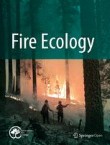Fire Ecology is the official journal of the Association for Fire Ecology.
Multitemporal lidar captures heterogeneity in fuel loads and consumption on the Kaibab Plateau
Characterization of physical fuel distributions across heterogeneous landscapes is needed to understand fire behavior, account for smoke emissions, and manage for ecosystem resilience. Remote sensing measureme...
